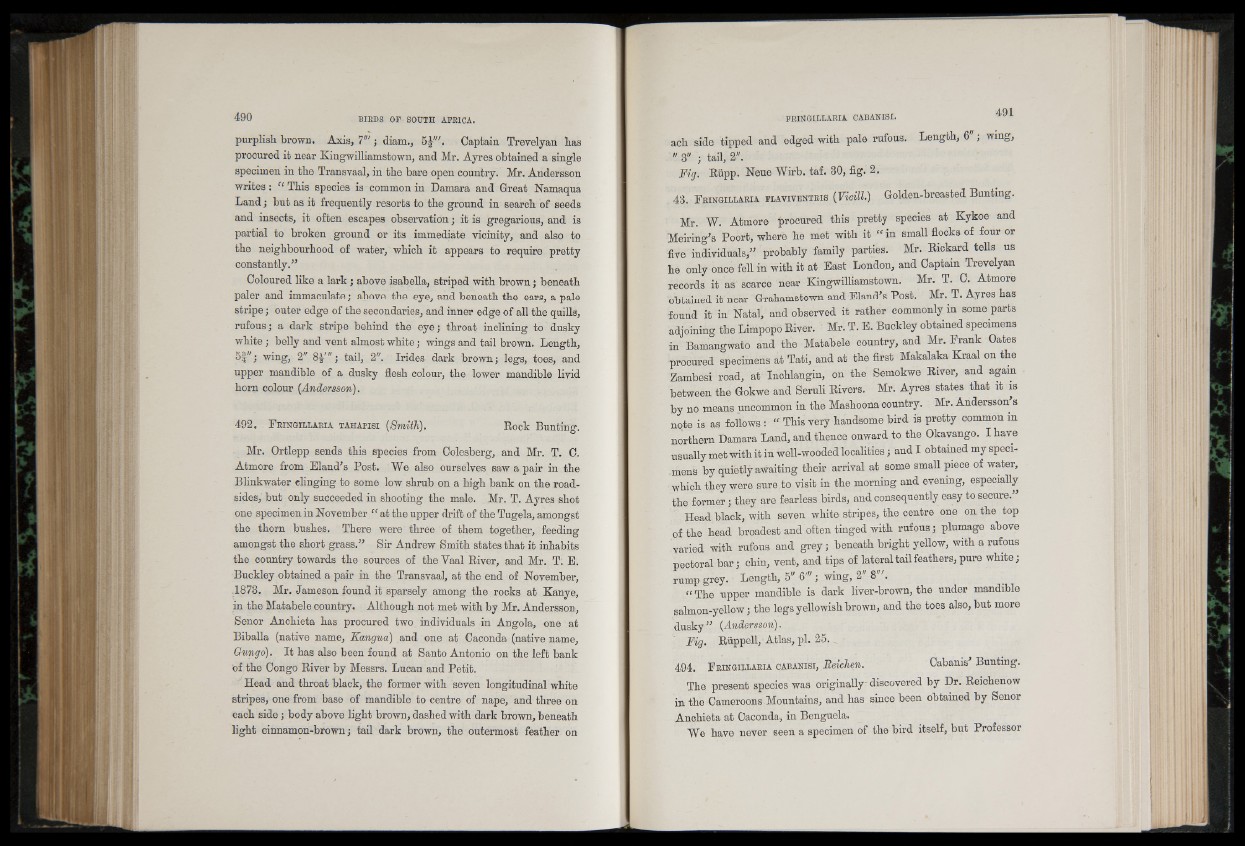
purplish brown. Axis, 7" ; diam., 5£'". Captain Trevelyan has
procured it near Kingwilliamstown, and Mr. Ayres obtained a single
specimen in the Transvaal, in the bare open country. Mr. Andersson
writes: “ This species is common in Damara and Great Namaqua
Land; but as it frequently resorts to the ground in search of seeds
and insects, it often escapes observation] it is gregarious, and is
partial to broken ground or its immediate vicinity, and also to
the neighbourhood of water, which it appears to require pretty
constantly.”
Coloured like a lark; above isabella, Btriped with brown; beneath
paler and immaculate; above the eye, and beneath the ears, a pale
stripe; outer edge of the secondaries, and inner edge of all the quills,
rufous; a dark stripe behind the eye ; throat inclining to dusky
white; belly and vent almost white; wings and tail brown. Length,
5f"; wing, 2" 8^'"; tail, 2". Irides dark brown; legs, toes, and
upper mandible of a dusky flesh colour, the lower mandible livid
horn colour {Andersson).
492. F r in g il la r ia t a h a p is i (Smith). Rock Bunting.
Mr. Ortlepp sends this species from Colesberg, and Mr. T. C.
Atmore from Eland’s Post. We also ourselves saw a pair in the
Blinkwater clinging to some low shrub on a high bank on the roadsides,'
but only succeeded in shooting the male. Mr. T. Ayres shot
one specimen in November “ at the upper drift of the Tugela, amongst
the thorn bushes. There were three of them together, feeding
amongst the short grass.” Sir Andrew Smith states that it inhabits
the country towards the sources of the Yaal River, and Mr. T. E.
Buckley obtained a pair in the Transvaal, at the end of November,
1873. Mr. Jameson found it sparsely among the rocks at Kanye,
in the Matabele country. Although not met with by Mr. Andersson,
Senor Anchieta has procured two individuals in Angola, one at
Biballa (native name, Kangua) and one at Caconda (native name,
Gungo). It has also been found at Santo Antonio on the left bank
of the Congo River by Messrs. Lucan and Petit.
Head and throat black, the former with seven longitudinal white
stripes, one from base of mandible to centre of nape, and three on
each side; body above light brown, dashed with dark brown, beneath
light cinnamon-brown; tail dark brown, the outermost feather on
ach side tipped and edged with pale rufous. Length, 6 '; wing,
" 3" ; tail, 2".
Fig. Rupp. Neue Wirb. taf. 30, fig. 2.
43. F r in g il la r ia f la v iv en tr is (Vieill.) Golden-breasted Bunting.
Mr. W. Atmore procured this pretty species at Kykoe and
Meiring’s Poort, where he met with it “ in small flocks of four or
five individuals,” probably family parties. Mr. Rickard tells us
he only once fell in with it at East London, and Captain Trevelyan
records it as scarce near Kingwilliamstown. Mr. T. C. Atmore
obtained it near Grahamstown and Eland’s Post. Mr. T. Ayres has
found it in Natal, and observed it rather commonly in some parts
adjoining the Limpopo River. Mr. T. E. Buckley obtained specimens
in Bamangwato and the Matabele country, and Mr. Frank Oates
procured specimens at Tati, and at the first Makalaka Kraal on the
Zambesi road, at Inchlangin, on the Semokwe River, and again
between the Gokwe and Seruli Rivers. Mr. Ayres states that it is
by no means uncommon in the Mashoona country. Mr. Andersson s
note is as follows : “ This very handsome bird is pretty common m
northern Damara Land, and thence onward to the Okavango. I have
usually met with it in well-wooded localities; and I obtained my specimens
by quietly awaiting their arrival at some small piece of water,
which they were sure to visit in the morning and evening, especially
the former; they are fearless birds, and consequently easy to secure.”
Head black, with seven white stripes, the centre one on the top
of the head broadest and often tinged with rufous; plumage above
varied with rufous and grey; beneath bright yellow, with a rufous
pectoral bar; chin, vent, and tips of lateral tail feathers, pure white;
rump grey. Length, h" ; wing, 2 8 .
“ The upper mandible is dark liver-brown, the under mandible
salmon-yellow; the legs yellowish brown, and the toes also, but more
dusky” (Andersson). ,
Fig. Ruppell, Atlas, pi. 25. _
494. F r in gil la r ia cabanisi, Beichen. Cabanis’ Bunting.
The present species was originally- discovered by Dr. Reichenow
in the Cameroons Mountains, and has since been obtained by Senor
Anchieta at Caconda, in Benguela.
We have never seen a specimen of the bird itself, but Professor